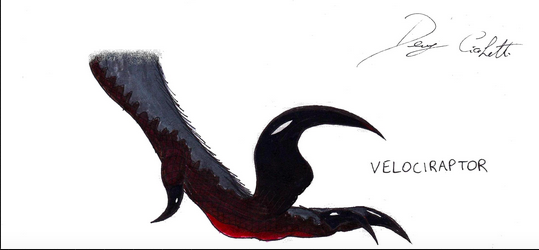The sickle shaped claw of Velociraptor has commonly been thought of as a tool to slash and disembowel prey. However, a study by Manning et al. (2006) suggests an alternate use of the claw. They suggest that the claw was actually used for gripping onto struggling prey items while the Velociraptor used its jaws to mortally wound the prey.

They came to this conclusion by building a robotic rig of a Deinonychus antirrhopus leg made of an aluminum core that was covered in a Kevlar sheath (Manning et al. 2006). The point of using the Kevlar sheath was to represent the keratin sheath that likely covered the claw in life (Manning et al 2006). The authors noted that the model claw that they used was 40-50 times stiffer than an ostrich claw (Manning et at. 2006). Therefore, if the robotic claw could not cut into flesh, a real claw would be unlikely to do that either (Manning et al. 2006).
They tested the claw against a fresh pig carcass and noted that the claw didn't produce a gaping slash wound (Manning et al. 2006). Instead, it produced a puncture wound that was only 30-40 mm deep (Manning et al. 2006). The authors noted that this was unlikely to be able to seriously hurt anything but smaller prey (Manning et al. 2006). Interestingly, they noted that the flesh below the puncture wound bunched up which prevented the claw from slipping out of the wound (Manning et al. 2006).
As such, the authors suggest that the claw was not used for slashing prey, but instead could have been used to grip onto large prey that the Velociraptor had jumped onto while they attacked the prey with their jaws (Manning et al. 2006). In this way, the prey animal would not be able to properly face the Velociraptor because as it swung its' body around, the Velociraptor would move with it (Manning et al. 2006). In fact, some big cats use a similar technique in which they use their claws to hold onto and move with the prey while they deliver the killing blow with their jaws (Manning et al. 2006).

These days, it has become common knowledge that Velociraptor had feathers. However, have you ever wondered how scientists came to this conclusion?
One interesting article provides an example of how this conclusion was reached. The scientists were examining a Velociraptor fossil and noted quill knobs on the back of one of the forearm bones (Turner et al. 2007). (Quill knobs are raised knobs of bone where quills of secondary feathers are attached) (Turner et al. 2007). This is important, because among modern birds quill knobs are considered a definitive indication of the presence of feathers in life (Turner et al. 2007).
They noted 6 quill knobs on the arm bone with space on the arm bone for 8 more (Turner et al. 2007). This means that there were at least 14 feathers on the arm of this individual (Turner et al. 2007).

One exciting part about paleontology is using clues in the fossil record to learn things about animals that are not directly preserved. For example, scientists were able to figure out pterosaurs were part of the Velociraptor diet and that Velociraptor's did engage in scavenging behaviour.
They determined this by examining a Velociraptor fossil that had a broken pterosaur bone in its chest cavity in an area where its stomach would have been in life and noted that the bone did not appear to have been damaged by stomach acids (Hone et al. 2012). This means that the Velociraptor liekly died soon after eating the bone (Hone et al. 2012).
Furthermore, they note that the Velociraptor likely scavenged the meal because based on the size of the bone, the pterosaur that it belonged to was at least 9kg in weight with a wing span of at least 2.5m while the Velociraptor was about 13 kg and was not fully grown at the time of death (Hone et al. 2012). Given the massive size difference, the scientists believe that it would have been difficult for the Velociraptor to have taken down the pterosaur unless it was injured or infirm (Hone et al. 2012). Furthermore, if the Velociraptor had taken down the pterosaur it seems unlikely that it would have favoured eating a bone rather than meat -unless it was looking for minerals found in the bone (Hone et al. 2012).
Another interesting aspect to this, is that another study also found that another dromaeosaurid (a general term for the group of dinosaurs that Velociraptor belongs) also appeared to eat pterosaurs(Hone et al. 2012;). This suggests that eating pterosaurs was common among dromaeosaurid dinosaurs (Hone et al. 2012).
First published on: Oct. 28, 2023.